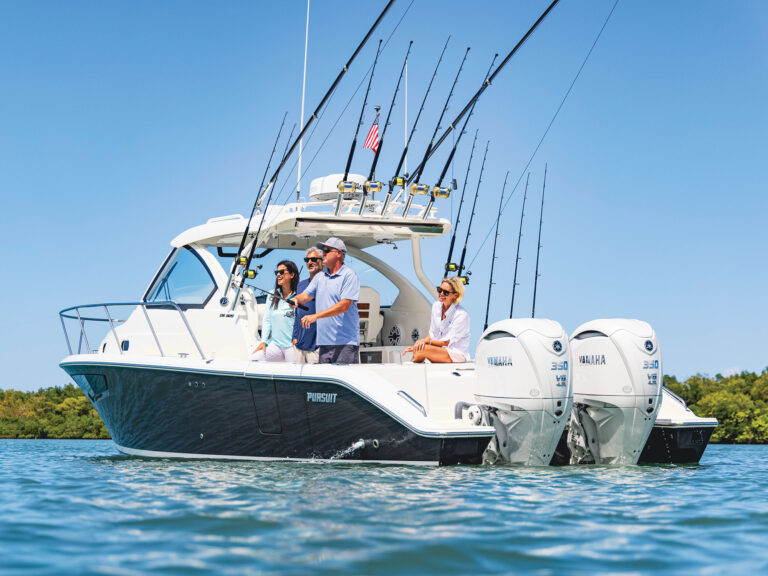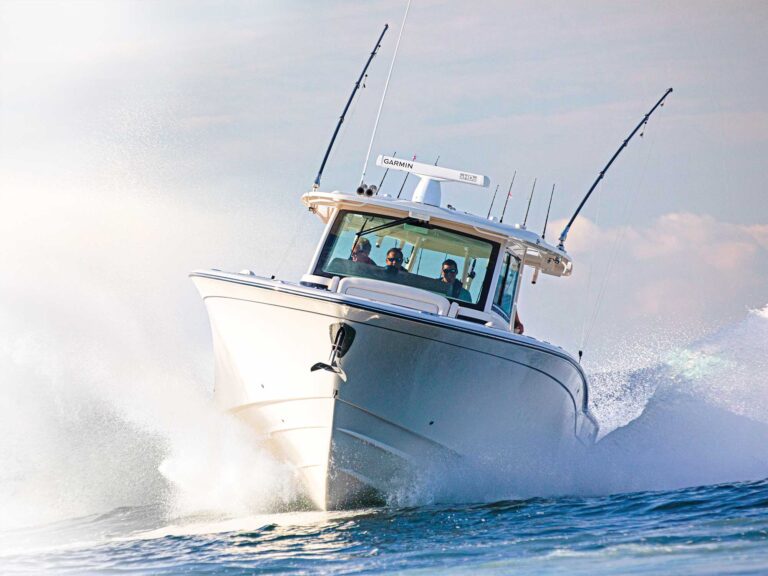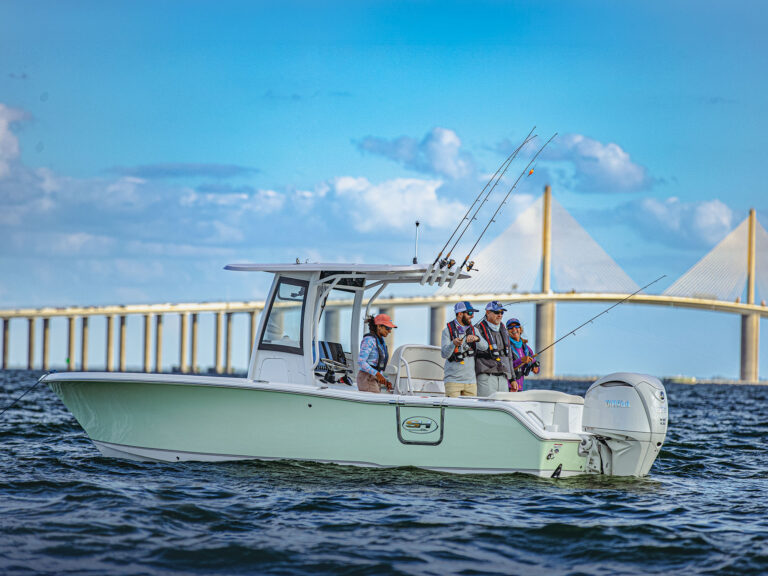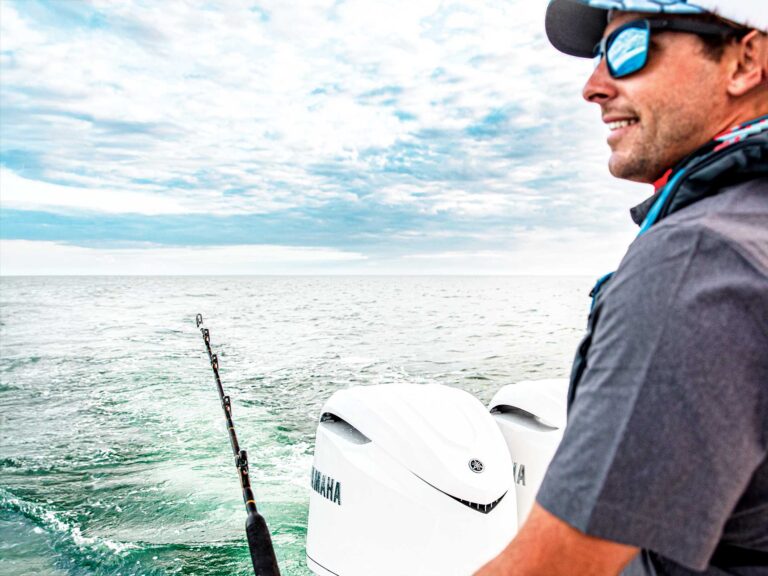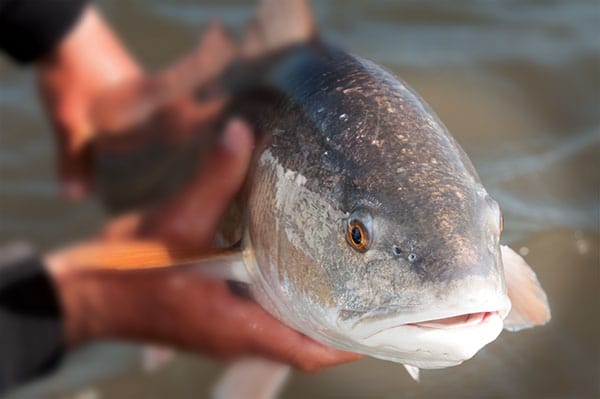
One of the great things about redfish, also called red drum, is their overall obliging nature. But at times, locating them comes with difficulty. And even when they’re pinpointed, enticing a strike on a lure or bait requires strategy and skill. Whether you’re new to this species or you consider yourself an expert on how to catch redfish, you can up your odds even more by following the advice of the three pros we talked to about fishing for redfish.
Jeff Crabtree learned something late last summer during a charter trip with some anglers who just wanted to bend rods and catch a few red drum. While running in his boat, he saw birds diving and commotion at the surface from big ladyfish feeding on small menhaden. He slowed down and eased up to the action with an electric motor, and his anglers fired jigs into the melee. Instantly they hooked into 2- and 3-pound ladyfish, a fun beginning to a hot fishing day.
As an angler brought the first ladyfish to the boat, a huge redfish appeared below it, trying to eat it. Then another redfish showed, then a third, and finally one of the 25-pounders ate the hooked ladyfish whole!
“I knew that cut ladyfish were one of the best redfish baits there is, but I didn’t know bull reds would eat a whole 3-pounder,” says Crabtree.
Crabtree rigged stouter plug rods with 1- to 2-ounce grub jigs, ran up-tide from the surface-schooling ladyfish, and bounced jigs below them. Immediately he was into giant redfish, 15- to 40-pounders, as many as his clients wanted to catch. And that tactic has since proved fruitful for Crabtree wherever ladyfish schools and bull redfish reside.
Fishing for red drum isn’t rocket science, but there are more than a few tricks you can use to increase your catch count, such as knowing the best destinations for catching redfish. Keep reading for tips on the best time to catch redfish, what lures and baits work best, and additional redfish fishing tips.
Locating and Catching Redfish
Putting in time is vital to consistently catching redfish, and nothing replaces experience when it comes to studying their habits.
“You’ve got to enjoy the hunt for redfish as much as catching them,” he says. “Some of my best fishing spots I’ve located simply by dropping my trolling motor and buzzing down a shoreline looking for fish without even a rod in my hand. This is a great way to locate fish, and then come back the next day with anglers to the same spot, with identical tide and weather conditions. You can bet reds will be there.
“TOW (time on the water) demands that a fisherman look for new hot spots, and prevents pressuring prime redfish places you already know. You just can’t keep beating up one or two spots, and you sure don’t want to put all of your eggs in one location basket for chartering redfish or fishing tournaments.”
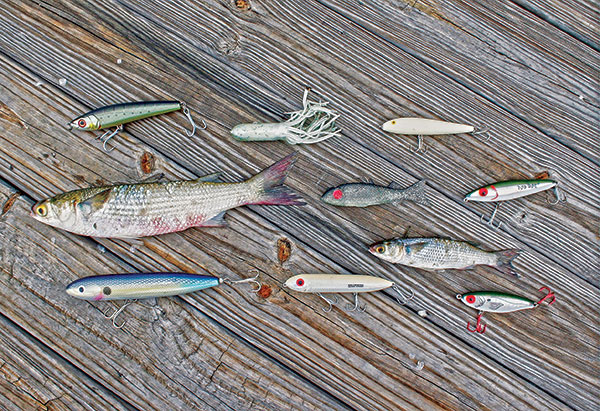
(Pictured above)
1 Yo-Zuri Sashimi Slider Metallic; 2 Tora Tube; 3 Rebel Jumpin’ Minnow; 4 DOA Swimmin’ Mullet; 5 MirrOlure Top Dog; 6 Heddon Mega-Spook; 7 Heddon Saltwater Super Spook; and 8 MirrOlure Catch 5.
Lures for Redfish
There is much to learn when figuring out how to catch redfish, but when it comes to lures, Crabtree believes the size of redfish lures and their presentation are more important than lure color.
“You’ve got to think about how the redfish perceive the lures you’re casting to them,” he says. “You don’t want to throw a big mullet-imitating plug when reds are chasing grass shrimp in the shallows. “Try to imitate the prey the reds are targeting with the lures you choose. If reds are eating small crabs, casting small paddletail jigs might be great. Lures should match the size of baits. A lure designed to imitate a shrimp shouldn’t be worked like a mullet or menhaden.”
Once inshore water gets above 55 degrees, Frederick starts looking for mud and shell flats at the mouths of bays and bayous that are jammed with jumping mullet in the 6- to 8-inch range. This is prime forage for good-size redfish. Diving pelicans often lead the way to such bait schools — and the redfish feeding on them.
This pattern works well February through May along the Gulf Coast, says Frederick.
“I drift big flats in 2 to 5 feet of water, and make long casts with ¼-ounce Egret Wedgetail grub jigs because the tail vibration of that plastic body perfectly mimics a frantic mullet,” he says. “It’s deadly, and triggers strikes from reds that aren’t even feeding. They just react and hit when it comes by. I fish it fast, and want to feel that wiggling tail just thumping during a retrieve. I never let it touch bottom.”
Sometimes getting live bait is impossible, and that’s when good lures come into their own. Recently Shaughnessy has come to rely on an ultra-realistic shrimp jig called the Vudu by Egret Baits.
“It’s a little pricey, but it really works, and it holds up better than many other soft-plastic shrimp jigs I’ve tried,” he says. “It’s made with super-tough plastic, and it’s so realistic that I regularly catch mangrove snapper and sheepshead with it when fishing for redfish.
Texas Redfish Eat Shrimp in the Summer
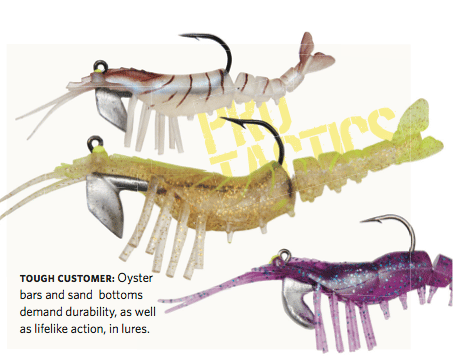
From midsummer to early fall, bait is small along much of the Texas Gulf Coast, especially on sprawling Sabine Lake, Frederick’s home water. Redfish seek out pods of shrimp and feed ravenously on them.
“I look for small birds feeding on shrimp to help locate redfish,” he says. “Terns and sea gulls diving on bait is usually a tipoff to shrimp schools that have redfish working them too.
“Casting jigs into the area works, but I’ve had better success using a popping cork with a good shrimp-imitating jig in brown or off-white. It works best when that cork is popping, shaking and rattling across the surface throughout a retrieve.”
Often during cold fronts, redfish will not hit a lure retrieved in a straight line, preferring artificials or even baits that wobble, says Shaughnessy.
“That’s when you’ve really got to manipulate a lure, or even a natural bait like a jig-and-minnow, mullet or mud minnow on a jig.
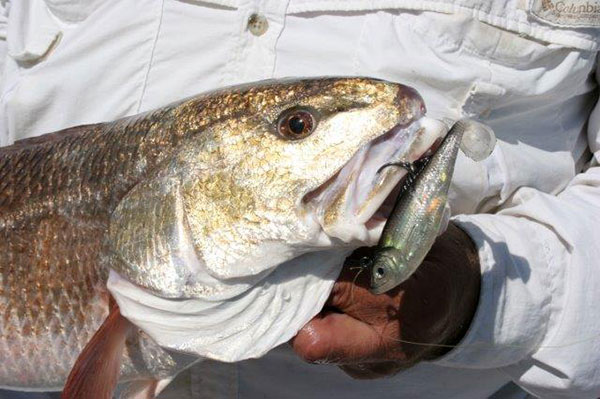
Fish Crankbaits Near Jetty Rocks for Redfish
In fall, heavyweight redfish push into inlets and passes lined by rock jetties.
Frederick works jetties by casting big, rugged deep-diving plugs in 10 to 18 feet of water. “The best jetty spots are isolated rocks or clusters of rocks a bit removed from a standard jetty line,” he explains. “The places are formed when rocks roll off the jetty line during construction, and they’re usually in a little deeper water than the jetty line itself.
“You can find them by feel with crankbaits, making long casts, but a good sonar helps a lot in locating them. These isolated rock piles are good year after year, and it’s smart to mark them with your GPS for future reference.”
“Lots of twitches, hops, and stop-and-go actions turn on redfish, and make them hit a lure they refuse when retrieved straight with no rod action.”
Use Sonar to Locate Redfish
Side-scan sonar is a huge timesaver when searching for redfish, says Shaughnessy, who uses the tactic often on his home water of Lake Calcasieu, Louisiana.
“You can eliminate a lot of unproductive water in a hurry. I can cast ahead of my boat, and watch the sonar to the sides of my skiff too. The sonar picks up bait, individual redfish and, of course, oyster bars, channels, little humps — anything that might hold redfish off to the side. It’s really a timesaver when fishing unfamiliar open water, like bays, river mouths, sounds and inlets.”





